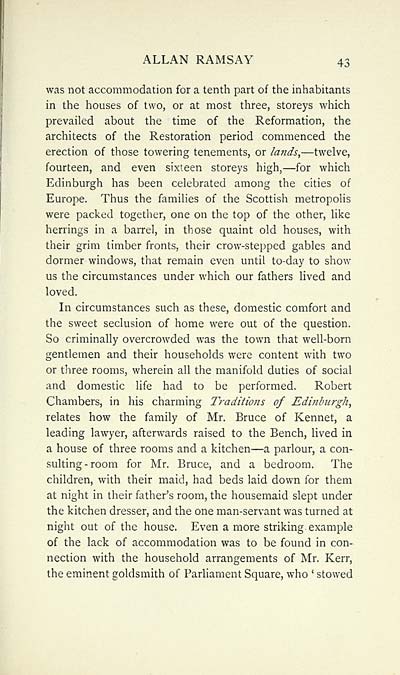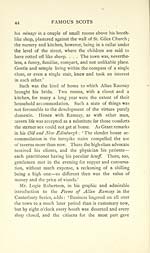Glen Collection of printed music > Printed text > Allan Ramsay
(47) Page 43
Download files
Complete book:
Individual page:
Thumbnail gallery: Grid view | List view

ALLAN RAMSAY 43
was not accommodation for a tenth part of the inhabitants
in the houses of two, or at most three, storeys which
prevailed about the time of the Reformation, the
architects of the Restoration period commenced the
erection of those towering tenements, or lands^ — twelve,
fourteen, and even sixteen storeys high, — for which
Edinburgh has been celebrated among the cities of
Europe. Thus the families of the Scottish metropoHs
were packed together, one on the top of the other, like
herrings in a barrel, in those quaint old houses, with
their grim timber fronts, their crow-stepped gables and
dormer windows, that remain even until to-day to show
us the circumstances under which our fathers lived and
loved.
In circumstances such as these, domestic comfort and
the sweet seclusion of home were out of the question.
So criminally overcrowded was the town that well-born
gentlemen and their households were content with two
or three rooms, wherein all the manifold duties of social
and domestic life had to be performed. Robert
Chambers, in his charming Traditions of Edinburgh^
relates how the family of Mr. Bruce of Kennet, a
leading lawyer, afterwards raised to the Bench, lived in
a house of three rooms and a kitchen — a parlour, a con-
sulting-room for Mr. Bruce, and a bedroom. The
children, with their maid, had beds laid down for them
at night in their father's room, the housemaid slept under
the kitchen dresser, and the one man-servant was turned at
night out of the house. Even a more striking, example
of the lack of accommodation was to be found in con-
nection with the household arrangements of Mr. Kerr,
the eminent goldsmith of Parliament Square, who ' stowed
was not accommodation for a tenth part of the inhabitants
in the houses of two, or at most three, storeys which
prevailed about the time of the Reformation, the
architects of the Restoration period commenced the
erection of those towering tenements, or lands^ — twelve,
fourteen, and even sixteen storeys high, — for which
Edinburgh has been celebrated among the cities of
Europe. Thus the families of the Scottish metropoHs
were packed together, one on the top of the other, like
herrings in a barrel, in those quaint old houses, with
their grim timber fronts, their crow-stepped gables and
dormer windows, that remain even until to-day to show
us the circumstances under which our fathers lived and
loved.
In circumstances such as these, domestic comfort and
the sweet seclusion of home were out of the question.
So criminally overcrowded was the town that well-born
gentlemen and their households were content with two
or three rooms, wherein all the manifold duties of social
and domestic life had to be performed. Robert
Chambers, in his charming Traditions of Edinburgh^
relates how the family of Mr. Bruce of Kennet, a
leading lawyer, afterwards raised to the Bench, lived in
a house of three rooms and a kitchen — a parlour, a con-
sulting-room for Mr. Bruce, and a bedroom. The
children, with their maid, had beds laid down for them
at night in their father's room, the housemaid slept under
the kitchen dresser, and the one man-servant was turned at
night out of the house. Even a more striking, example
of the lack of accommodation was to be found in con-
nection with the household arrangements of Mr. Kerr,
the eminent goldsmith of Parliament Square, who ' stowed
Set display mode to: Large image | Transcription
Images and transcriptions on this page, including medium image downloads, may be used under the Creative Commons Attribution 4.0 International Licence unless otherwise stated. ![]()
| Special collections of printed music > Glen Collection of printed music > Printed text > Allan Ramsay > (47) Page 43 |
|---|
| Permanent URL | https://digital.nls.uk/91278850 |
|---|
| Description | Scottish songs and music of the 18th and early 19th centuries, including music for the Highland bagpipe. These are selected items from the collection of John Glen (1833 to 1904). Also includes a few manuscripts, some treatises, and other books on the subject. |
|---|
| Description | The Glen Collection and the Inglis Collection represent mainly 18th and 19th century Scottish music, including Scottish songs. The collections of Berlioz and Verdi collected by bibliographer Cecil Hopkinson contain contemporary and later editions of the works of the two composers Berlioz and Verdi. |
|---|

